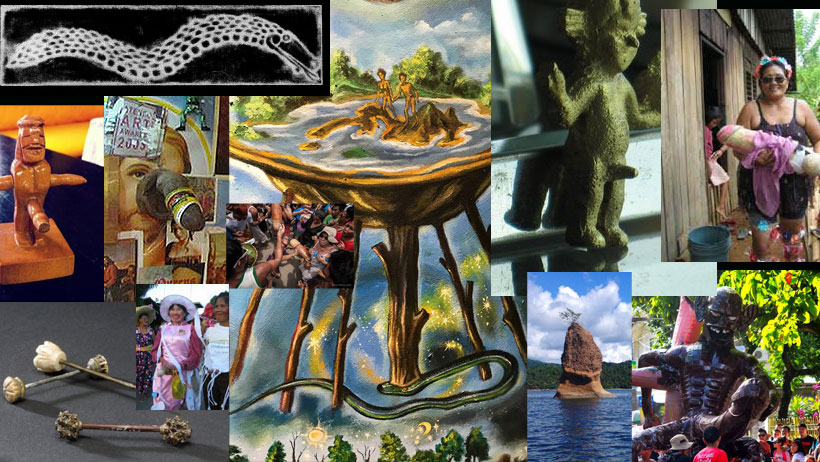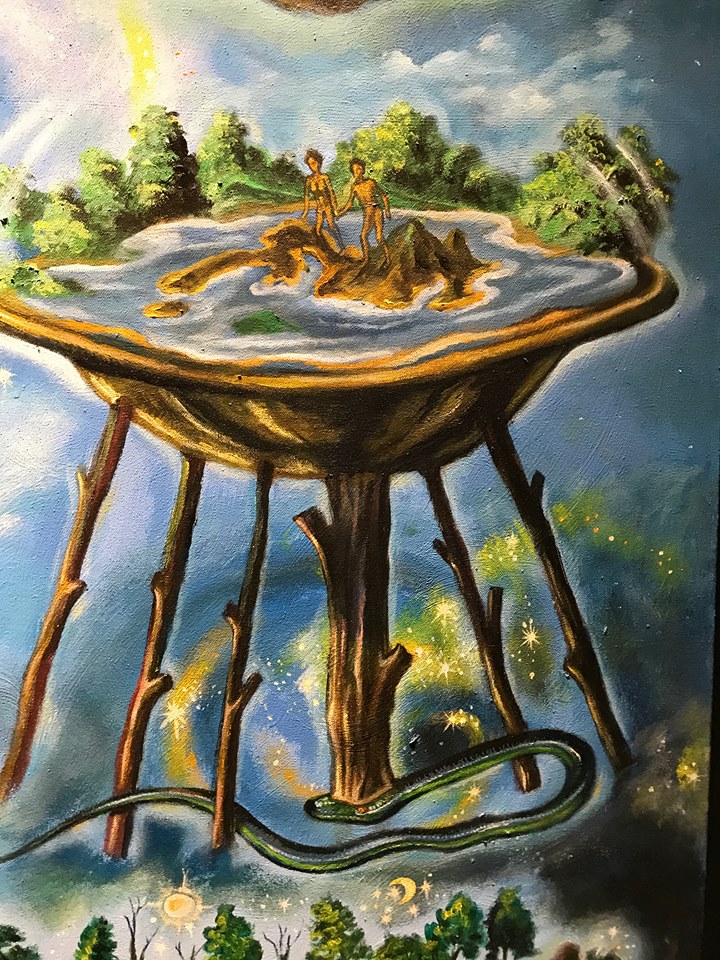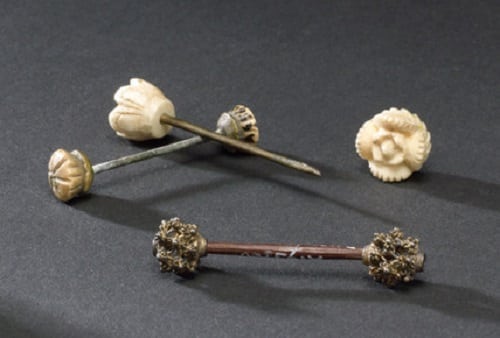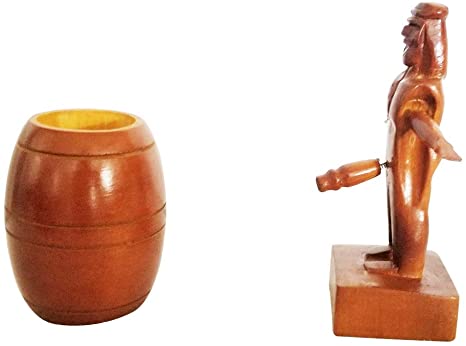
Last week I was researching the early Philippine image of a conjoined male and female. I was exploring symbols that considered how, prior to Spanish conquest, many indigenous societies in the Philippines, as in the rest of insular Southeast Asia, were sexually egalitarian. Spanish chroniclers of the Visayas were struck by the socioreligious, political, and economic equality between men and women. This course of research brought me to a Blaan origin myth:
How the Male Came to Be Distinguished from the Female
It is a popular belief among the Blaans that in the olden days a man could not be distinguished from a woman. There was no such word as man or woman. In fact, the genital organs of the male and female were all located in each individual. The penis was located on one knee and the vagina on the other. Tasu Weh was the maker of this.
Fiu Weh noticed that the individual was unable to work anymore. The individual was busy in sex act most of the time. Because of this, Fiu Weh told Tasu Weh that the individual should either have a male or female organ only. But Tasu Weh refused to change the placement. “If you want to make one with a penis and another with a vagina, go ahead! I’ll not change mine.” So Fiu Weh created an individual with a penis only, another with a vagina. He saw that it was good. Since that time the person with a penis is called a man and the person with a vagina is called woman.
It appears that the early Blaan story tellers were not without a sense of humor. I began to reflect on the weird and fantastical penis stories I have encountered in Philippine Folklore and also the lack of phallic imagery when compared to other polytheistic belief structures. I admit that I often dissect and correct some of the arguments made about gender in the pre-colonial Philippines, but the lack of phallic imagery does seem to give balance to some of the points made by many of the feminist advocates of the 1990’s. I’m not sure if documentation of Philippine beliefs have been wiped clean by more conservative chroniclers, or if this is such a taboo subject that it has not been delved into deeper. I felt it was time to begin the conversation.
Before we start, a phallus is a penis (especially when erect), an object that resembles a penis, or a mimetic image of an erect penis. Any object that symbolically—or, more precisely, iconically —resembles a penis may also be referred to as a phallus; however, such objects are more often referred to as being phallic (as in “phallic symbol“). Such symbols often – but not always – represent fertility, power, creation and cultural implications that are associated with the male sexual organ, as well as the male orgasm.
In a future article, I will also be exploring the “yonic” images (female equivalent to phallic) – which may number more than the phallic imagery in Philippine creation myths.
Phallic Symbols in Philippine Myths (or lack thereof)
I’d be remiss to write an article on phallic imagery and not mention the snake. The serpent is a universal and complex symbol. It can represent death, destruction, evil, a penetrating legless essence, and/or poison. In the Christian tradition, Satan (in the guise of the serpent) instigated the fall by tricking Eve into breaking God’s command. Thus, after the Christianization of many Philippine beliefs, the serpent began to represent temptation, the devil, and deceit. The snake can have positive implications and it can be associated with good omens, healing and/or rebirth; as it sheds its skin.

Image Credit: The Soul Book
According to Alcina (1668), the ancient Bisayans believed that a snake could be born with some o f the male children. Indeed a woman in his parish reported giving birth to a snake that was reddish from the head to the middle of its body and black up to the tip, its scales glistening. It kept following her baby and curled beside it. Although she was upset, others considered this a good omen, for great warriors were accompanied by such snakes on their wars. The latter rode on their ships and disembarked with them into the serpent heads.
A variant of the Mandaya creation of people story says a limokon (a kind of dove), laid two eggs on a river bed and that one hatched a woman, the other a snake. The snake went down the current until it arrived at the place where the sea and the river meet. There it blew up and a man emerged from its carcass.
The snake is phallic, but also can be seen as androgynous, which I find to be the case with many Philippine myths. It should be noted that it may simply be the English language re-telling of serpent and moon-eater myths that distinguish them as he or she.
In the Bukidnon epic, great logs were made into pillars for the construction of the house of the hero, Agyu. The first posts planted were to be driven down and stopped only when they touched the forehead of the Intumbangol (Opeha 1979), a pair of serpent deities who support the earth from the underworld. One snake is a male and the other a female and they lie to form a cross, their mouths below the water at the point where the earth and sky meet. When the Intumbangol move they cause earthquakes; when they breathe they cause the winds; when they pant they cause violent storms. The Intumbangol do not fall down because they are held up by the great god Magbabaya (Cole 1956). These snakes represent the chaos, unruliness and purposelessness of life. Agyu has first to subdue the Intumbangol before he can construct his house which represents peace and order.

Painted By: Nonoy Estarte
Another version of the creation, prevalent among the Manobos of the Argawan and Hibung Rivers, gives control of the world to Dagau, who lives at the four fundamental pillars in the company of a python. Being a woman, she dislikes the sight of human blood, and when it is spilled upon the face of the earth she incites the huge serpent to wreathe itself around the pillars and shake the world to its foundations. Should she become exceedingly angry she dimishes the supply of rice either by removing it from the granary or by making the soil unproductive.
According to another variation of the story, which is heard on the upper Agusan, on the Simulau, and on the Umaiam, the world is like a huge mushroom and it is supported upon an iron pillar in the center. This pillar is controlled by the higher and more powerful order of deities who, on becoming angered at the actions of men, manifest their feelings by shaking the pillar, thereby reminding mortals of their duties.
Okay, so what about all these pillars? I believe it has more to do with the archaic conception of Earth‘s shape as a plane or disk than anything phallic. Unlike in other mythology where the serpent is seen to often represent masculine attributes, Philippine Mythology often portrays it as a non-gendered powerful being.
Phallic Idols
It is not uncommon to see the grainery idols (Bulul) of the Ifugao showing male or female genitalia, but it is unknown if the pre-colonial Philippines had any phallic idols. I’d be very interested to hear from you if you know of any documentation on the topic.
Mythical Phalluses
LAKANBAKOD was a Taglog deity who had gilded genitals as long as a rice stalk and was offered eels when fencing swiddens—because, they said, his were the strongest of all fences.
The 1595 Boxer Codex entry is as follows: “One of these is the god they call Lakan Bakod, whom they believe is the god of the fruits of the earth. And when they have need of him they hold a banquet and revel in the fields under a canopy that they construct there for this purpose and where they erect a kind of altar. On this altar they place a wooden statue whom they say is the god Lakan Bakod; he has gold teeth and eyes and gilded genitalia, the size of which is as big as they want their spikes of rice to be. And its body is completely hollow. And those making the sacrifice form a ring and eat and feast. And they have the priests that we have mentioned place some of the food they are to eat in the mouth of the god Lakan Bakod; they also give him some of the beverage they are to drink. And they are convinced that by reciting some superstitious words he will give them the very good and abundant fruits asked of him.”
TAMBALUSLOS is a tall humanoid creature from Bicol. Generally black in complexion, it has long and thin legs with big joints, hooves, long thin arms and fingers, and a mane that runs from the back of the head down to its buttocks. It also has wide protruding lips like an ape. Another strange feature of this creature is that it has a long wrinkled penis and loose testicles which dangle on the ground. The creature’s name is derived from this feature which is referred to as ‘luslus’ which means ‘loose and hanging’. The Tambaluslos chases people who wander in the woods. The only way to escape it is to take off your clothes and wear them upside-down. The creature finds this act very hilarious and it will laugh so much that its wide lips would cover its face, therefore preventing it from seeing the victim who in turn will have ample time to escape.
KULAKOG is a legendary giant from Bicol who was said to use his penis in a very unique manner during a Moro raid: “The Moros trembled when they heard his voice and escaping quickly, they left behind all their captives. Kulakog saw where they were from afar and stretching his phallic organ he told his mother to use it as a bridge to come to where he was. His mother thus crossed the Bikol river and all the captives followed her.”
MANTIW are giant spirits in Iloilo over thirty feet tall. They are usually seen roaming the fields or leaning against a coconut or Buri tree alone while whistling melodiously. People who have allegedly seen a Mantiw describe it as having a fair complexion, wide shoulders, and a tall aquiline nose. Also, a male Mantiw has an incredibly long penis and large, dangling scrotum. Although peaceful, a Mantiw is easily offended when a human whistles along with it. It will grab the nuisance human, carry him to the tallest coconut tree, and leave him on top with no means of climbing down.
TIKBALANG – (Tagalog and other regions) A half-man and half-horse creature, terrorizes women. Actually, they are summoned by shamans or landlords to secure and protect their house. It has a horse’s head, the body of a human but with the feet of the horse. It travels at night to rape female mortals. The raped women will then give birth to more tikbalang. They are also believed to cause travelers to lose their way particularly in mountainous or forest areas. Tikbalangs are very playful with people, and they usually make a person imagine things that aren’t real. Sometimes a Tikbalang will drive a person crazy. Another lesser discussed distinguishing feature of the Tikbalang is that his head is not the only part of his body that resembles a horse.
Other Phallic Deities:
LINGGA was considered a phallic Tagalog god. He caused illness if not recognized in daily activities. Later stories tell that for some reason, he had a change of heart. He then became the god who was responsible for curing diseases, hence a deity of medicines. There is no known emblem or image of Lingga. Lingga is said to be the deity who was first at the center of the pre-Christian fertility celebration called kasilonawan. The word is probably derived from sanskrit ‘lingam’ or ‘linga’ (लिङ्गम्). The Hindu deity Shiva is worshiped in the form of Shivling or Shiva Lingam, a penis-shaped statue.
BIBIT was also a phallic Tagalog god and partner of Lingga. He also caused illness if not given recognition in the ordinary course of daily activities. When Lingga shifted into a god of medicine, he continued to cause illness to people who do not recognize his existence in every day life. There is no known emblem or image of Bibit. The term “kuwentong bibit” to describe magical ‘fairy tales’ may have originated from the name of this deity.
Ethnic groups from various areas, particularly the Mountain Province, have numerous tales about giants and their exposed scrotums, but that doesn’t quite fit into this article. However, one giant does.
Kurakog & Irihan Rock Formations Legend
Called “Boto ni Kurakog” (“Kurakog’s penis”) because of its shape, this rock formation is the subject of many legends in Catanduanes. One of which says that Kurakog is a giant whose body was washed away by the waves after a deep slumber. It was only the pointed column, rising at five meters above the sea, that remained. Another popular belief says it’s a symbol of the undying love of “Kurakog” for a mortal lady from Bagamanoc named “Kalarab.”
For Her Pleasure
The first European to record Filipino sexual practices were Antonio Pigafetta and Fray Juan de Plasencia.
“The males, large and small, have their penis pierced from one side to the other near the head with a gold or tin bolt as large as a goose quill. In both ends of the same bolt, some have what resembles a spur. with points upon the ends. others are like the head of a cart nail. I very often asked many, both young and old, to see their penis, because I could not credit it. In the middle of the bolt is a hole through which they urinate. The bolt and the spurs always hold firm They say that the women wish it so, and that if they did otherwise they would not have ‘communication’ with them.
“When the men wish to have ‘communication’ with their women, the latter themselves take the penis not in the regular way and commence very gently to introduce it into their vagina with the spur on top first and then the other part. When it is inside it takes its regular position; and thus it is always inside until it gets soft, for otherwise they could not pull it out.”

These practices are not completely in the past. A fascinating part of the modern Filipino seafaring identity is the little-known and barely studied sexual practice of “bolitas,” or little balls. Many Filipino sailors make small incisions in their penises and slide tiny plastic or stone balls — the size of M&M’s — underneath the skin in order to enhance sexual pleasure for prostitutes and other women they encounter in port cities.
Phallic Festivals
There are “phallic” rituals in places like Laguna, Cagayan and Olango, Cebu, where women wear phalluses of exaggerated sizes while men put on women’s dresses in a ritual intended to confuse the storms. In this ritual held during the lowest high tide of the year, land animals are brought to the sea, and fishermen plant seeds on the beach to deceive the weather, in the hope that the storms, confused by this reversal of roles, would wreak their havoc on another island.
In Tanay, Rizal, old women wipe their tapis (skirts) on a huge stone phallus as part of a fertility rite. In neighboring Morong, though, it is the men who wear women’s clothes and pretend to be pregnant while being part of the wedding party.
In Kalayaan, Laguna, the lukayo dance with the bridal party, including a brass band, through the streets of the town, all the while making lewd movements and comments. While the ceremony is taking place inside the church, the women remain outside, dancing and joking.
Although many of the above festivals are thought to have originated from the Hindu influence on the archipelago, some have evolved to include other meanings.
The Baliw-baliw festival (baliw is a Filipino word for crazy or mad) was originally meant to confuse the weather, but now may symbolize the confusion of the faithful, who chose to illustrate their struggles in life through rituals learned from their pagan ancestors. People are showing the things we need to remember and don’t want to happen. Some are unexplainable experiences in terms of their beliefs and are also a way of reminiscing God’s wrath.
Quirky Pinoy Souvenirs, Charms, and Modern Art
The Barrel Man
A barrel man is a souvenir doll or statuette popular in the Philippines. The statuette usually consists of a crude male figurine carved out of wood, partially hidden inside a round wooden barrel. When the barrel is taken off, the male figure inside is revealed, sporting a prominent phallic protrusion in the lower part of the figure’s anatomy.
The souvenir is fairly common in gift shops in the Philippines and is somewhat popular among tourists who may be surprised the first time they encounter the object and lift its barrel. The souvenir’s origin is relatively unknown, but the figure has been referred to as an Igorot, suggesting that it may represent the mountain inhabitants of the country’s early history. Although unconfirmed, it has been suggested that Ben “Dizon” Tingzon is the originator of the original barrel man.

While the barrel-man is uniquely Pinoy, like the penis ashtray that can also be found in stalls selling mass produced tourist items, is likely devoid of any cultural significance – other than Filipinos having a wicked sense of humor.
Santo Ninong Hubad Anting-Anting
An amulet that can be found among the vendors of Quiapo features a brass figure of the Sto. Nino with an orb in his left hand. The figure has three rays emanating from its halo and an erect penis disproportionate in size with respect to the body. If you ask the vendor, it is meant to be an effective charm or gayuma to attract the opposite sex, especially among forlorn lovers. Denis Santos Villegas also documents the charm being popular among female sex workers wishing to attract clients and protect themselves against sexually transmitted infections. In Japan, the Kanayama Penis Shrine was also historically popular among prostitutes who wished to pray for protection from sexually transmitted infections.
Anting-Antings have undergone a vast transformation from the original stones, roots, bones and teeth they were originally created with. Catholicism systematically replaced the diwatas, duendes and deities these items represented with saints and other religious imagery. The Church in the Philippines merely tolerates the sale of these items outside their doors in Quiapo and Baclaran, but has expressed a vehement disapproval and warning for this particular image.
“Poleteismo” by Mideo Cruz
Arguably the most controversial installation in Philippine history is Mideo Cruz’s “Poleteismo” which was shut down during its display in the Cultural Center of the Philippines’ (CCP) Kulo exhibit. Why? The installation featured images of Jesus Christ with symbols of pop culture, also including a crucifix with a movable phallus. Religious groups and influential leaders were outraged and labelled it as “blasphemous,” which is not surprising given the conservative Catholicism prevalent in the country. It made international headlines; former First Lady Imelda Marcos described it as “shameful,” while P-Noy also supported closing the exhibit.

The representation of a phallus is almost everywhere. Some consider it a funny coincidence while others reckon it is deeply symbolic. Phallus adoration has been going on for centuries and all around the world people celebrate and worship the penis. Within Asia alone various public practices and rituals can be found in China, Korea, Japan, Thailand, India, Mongolia, Bhutan, and yes, even the Philippines. In our modern quest to understand the gender perceptions of pre-colonial Filipinos, this is a topic that should be explored.
Sources:
Barangay: sixteenth-century Philippine culture and society, William Henry Scott, Ateneo Press (1994)
The Boxer Codex
You Shall Be As Gods Anting-Anting and the Filipino Quest for Mystical Power, Dennis Santos Villegas, Vibal Foundation (2017)
Philippine Folk Literature: The Myths, Damina Eugenio UP Press (2001)
Philippine Folk Literature: The Legends, Damina Eugenio, UP Press (2001)
The Creatures of Philippine Lower Mythology, Maximo Ramos, Phoenix Publishing (1998)
THE SOUL BOOK, Demetrio, Coredero-Fernando, Zialcita, GCF Books 1990
THE BODY BOOK, Arriola, Alcantara, GCF Books 1993
Shiva Lingam – How the Worship of a Penis started in Hinduism, Posted By Swami Balendu
Jordan Clark is a Canadian born descendant of Scottish immigrants living on the homelands of the Lekwungen speaking peoples. His interest in Philippine myth and folklore began in 2004. Finding it difficult to track down resources on the topic, he founded The Aswang Project in 2006. Shortly after, he embarked on a 5 year journey, along with producing partner Cheryl Anne del Rosario, to make the 2011 feature length documentary THE ASWANG PHENOMENON – an exploration of the aswang myth and its effects on Philippine society. In 2015 he directed “The Creatures of Philippine Mythology” web-series, which features 3 folkloric beings from the Philippines – the TIKBALANG, KAPRE and BAKUNAWA. Episodes are available to watch on YouTube. Jordan recently oversaw the editing for the English language release of Ferdinand Blumentritt’s DICCIONARIO MITOLÓGICO DE FILIPINAS (Dictionary of Philippine Mythology) and is working on two more releases with fellow creators scheduled for release later this year. When his nose isn’t in a book, he spends time with his amazing Filipina wife of 20 years and their smart and wonderful teenaged daughter.




